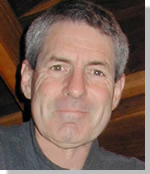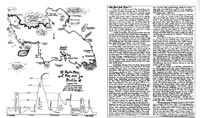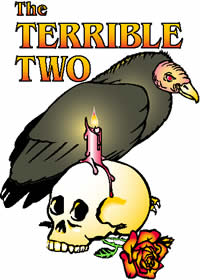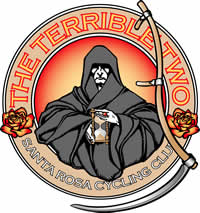 On The Road
On The Road
by: Bill Oetinger 7/1/2006
The Terrible Two...a brief history
We've just laid the 2006 edition of the Terrible Two to rest.
 If you've been reading these On the Road columns for any length of time at all, you have probably noted the occasional reference to this event. I might even make the assumption that you know what it is and that you know a fair amount about it. If you're interested in the Terrible Two, I suspect you will already have done the ride, worked on the ride in support, or at the very least have read or listened to other people's accounts of the ride.
If you've been reading these On the Road columns for any length of time at all, you have probably noted the occasional reference to this event. I might even make the assumption that you know what it is and that you know a fair amount about it. If you're interested in the Terrible Two, I suspect you will already have done the ride, worked on the ride in support, or at the very least have read or listened to other people's accounts of the ride.
Although I have alluded to it many times in other contexts, I have never written a column specifically about it. I propose to rectify that omission now. Call this a meandering history of the event. Not an exhaustive, all-inclusive chronicle, but just a rambling recollection of assorted anecdotes; tidbits trolled up out of my sketchy memory banks or out of the dog-eared documents packed into one drawer of a filing cabinet next to my desk...what passes for the Terrible Two's official archive.
If I am to take on this mantle of historian for the ride, the first thing I need to say is that my own involvement with the event only goes back to 1989, when the ride was already in its 13th season. What I know about those early years derives from a mish mash of old results sheets and write-ups, woven together with oral accounts passed on to me by the grizzled old veterans who were there at the beginning.
Basics first: the Terrible Two is a double century. A bicycle ride of 200 miles in one day. If we didn't have five digits on the end of each of our arms, we wouldn't use a decimal system for counting and we wouldn't attach any special significance to big numbers like 100 or 200. Plus, if we lived in the metric world, we wouldn't have any reason to be excited about a distance totaling, say, 323 kilometers, which is what 200 miles converts to. It's just an arbitrary number. But it happens to be a rather nice number, in that it adds up to a very good challenge for the recreational cyclist: just about the amount of miles a fit rider can knock off in the span of one dawn-to-dusk summer day.
You'll have to look elsewhere for a definitive history of the double century as a sporting activity. What little I know of it seems to indicate that organized doubles only came on the scene in the middle of the last century and didn't gain much of a following until just a few years ago. Even now, they occupy a very small niche in the vast tapestry of liesure time sports. What's more, I don't see a lot of doubles outside of California. There are a few, but the golden state seems to be the native habitat of the double century, thanks at least in part to the California Triple Crown double century series (more about that later).
The Terrible Two began in 1976. Our traditional history says that it was the creation of three local cyclists, Rod Mowbray, Gordon Burns, and Clifford Scott. They had done other doubles and felt that Sonoma County would make a dandy venue for one that was as scenic and as challenging as anything around. They fiddled with assorted combinations of roads, but quickly settled on a route that has pretty well stood the test of time. As Rod explained: "We put together a Skaggs Springs loop and a Geysers loop, then added Annapolis and Napa Valley in order to pick up the mileage." They considered going down to Mt Tam, but decided there was too much traffic in Marin County.
I'm probably biased, but I think the TT course has an honest, simple elegance. It doesn't go out of its way to find gratuitously steep climbs. It takes a straightforward, no-monkey-business approach to folding 200 miles of lightly traveled, very scenic country roads into our Sonoma County backyard, with a little wiggle through Napa County thrown in. The fact that it ended up with over 16,000' of hard climbing is simply a byproduct of our highly corrugated landscape. Believe me, without really trying, we could embellish this course with enough extra climbs to bump the total elevation gain up to over 20,000'. To their credit, our founding fathers resisted the temptation to do so, and those of us who have followed in their footsteps have not done so either.
Although the course has stayed true to its roots in broadest outline, it has undergone numerous minor changes over the years. In fact, it has changed in some small way almost every year, and in a few years, the changes have been significant. There have been at least six different start/finish venues and probably a couple of others I've forgotten. Assorted routes have been used for getting through the city of Santa Rosa. There was a year (1985) when, thanks to some idiot political posturing, the route had to stay out of Napa County, which neccesitated some fairly convoluted squiggles in the early going. The route through Napa Valley has changed in large ways and small on a number of occasions.
Without a doubt, the biggest change in the early years was brought about by the construction of Lake Sonoma. Up until 1980, the route had left the lunch stop via the shady road up the valley past the old Skaggs Springs spa. It was a long but easy climb to the summit at Las Lomas (where our second supplementary water stop is now). But when the waters filled in behind the dam, the Army Corps of Engineers built a new bypass around the lake that is certainly long, but nothing anyone would ever describe as gradual or shady. That's when the Terrible Two became truly terrible, when the riders had to tackle those endless, brutally steep, sunbaked walls that we now call the Killing Fields.
Mowbray, Scott, and Burns did a test ride of the course near Summer Solstice in '76, with their wives driving a support wagon, doling out water and Oreos as needed. Later in the summer, the first real TT took place. Gordon Burns--the owner of a local bike shop--is credited with bringing the Santa Rosa Cycling Club into the picture to support the ride.
Our records for the early years are rather spotty. No one figured the event was going to become an institution, so no one really bothered to keep track of the details. It was just a big, hard-assed bike ride. As far as we can tell, there were 26 starters for the August ride. We know of ten finishers, but there may have been more. No one kept track of the finishing times. We're pretty sure Ed Buonaccorsi--a local boy--finished first. He did so again in '77, and his time of 14:20 became our first course record. The last place finisher, in a time of 17:00, was Pete Penseyres, on a tandem with his wife Joanne. (He told her ahead of time they were "just going out for a ride.") One year later, Pete came back on a single and finished first, lowering the record to 12:45.
The club's support of those early rides was extremely Spartan. A lunch stop was provided. No rest stops. Minimal course marking. One or two sag wagons roving the course. In a few spots, gallon jugs of water left along the side of the roads. Nothing in the way of an after-ride celebration. Initially, the ride was thought of as daylight-only, and the cut-off was 9:00 pm. However, that seems to have gone by the wayside almost immediately, replaced by the now traditional 10:00 pm cut-off.
This matter of a cut-off time needs some further elaboration. Doubles are not races. Many of them are not timed. Those who enter often do so with the understanding that they have as long as they want to finish, or at least a very elastic time window for doing so. That is not the case with the TT. There is a mass start at 5:30 and the riders need to finish by 10:00 pm to be entitled to wear a coveted "I Did It!" t-shirt. Sixteen and a half hours may seem like a generous allowance, but with the topography the TT throws at you, it is barely enough for many riders and not enough for some. The ticking of the clock has always been a signature element in what makes the Terrible Two terrible. You not only have to be able to do the miles, you have to be able to do them with some dispatch...with at least a modest turn of speed.
 And speaking of those coveted t-shirts... They were not around at the earliest TT's. Patches were given out instead. I have never seen one of those patches, and I've only seen a few of the very early t-shirts. Graphics for the t-shirts and brochures in the early years were provided by Art Read, who was well known in those days as a talented and witty columnist for the late, lamented California Bicyclist magazine. His art and his brochure copy for those formative years were pivotal in shaping the mystique of the Terrible Two. Fortunately, my archives do include copies of most of the event fliers from '76 on up, and they make for wonderful reading.
And speaking of those coveted t-shirts... They were not around at the earliest TT's. Patches were given out instead. I have never seen one of those patches, and I've only seen a few of the very early t-shirts. Graphics for the t-shirts and brochures in the early years were provided by Art Read, who was well known in those days as a talented and witty columnist for the late, lamented California Bicyclist magazine. His art and his brochure copy for those formative years were pivotal in shaping the mystique of the Terrible Two. Fortunately, my archives do include copies of most of the event fliers from '76 on up, and they make for wonderful reading.
The event muddled along at the level of a local cult classic for most of its first 16 years. Attendance hit a high of 62 starters in 1982, then dribbled off to a low of 28 starters in 1988. Word filtered out into the wider world of California cyclists that this was a worthy challenge, so a handful of big guns would show up each year--racers and RAAMers--to give it a shot. Overall though, it was a tiny event with minimal support and next to no publicity. It was on such a shoestring, casual footing that in 1991, the unthinkable, but probably inevitable finally happened: the club essentially "forgot" to put on the ride. Those who should have been in charge all pretty much dropped the ball.
A few faint, plaintive wails were heard from the TT faithful...those few dozen hardy souls who looked forward to the ride each year. But mostly the club just said, "Oh well...sorry about that!" This is where I come into the picture. I had only become aware of the TT in 1989, when I rode up to the lunch stop to watch the leaders come through. I'm not sure I was even a member of the club at that point, and I certainly wasn't involved in any leadership role. The next year I hung out at the finish to watch the riders come in. I was a few years away from being able to do a double myself at that point, but the idea intrigued me, especially the idea of the Terrible Two: so hard and yet so scenic. So epic! I was hooked.
And then, the next year...nothing. No Terrible Two! How could that be? It seemed like such a cool event. It couldn't be allowed to simply fall through the cracks and become just a memory. So I got involved.
Bike clubs are all about volunteers. If no one steps forward to take on the tasks that need doing, they don't get done. I stepped into the breach for the TT in '92 and made it something of a personal obsession to see it thrive and prosper. But I was fortunate in my timing. After that low point of disinterest in '91, the entire club enjoyed a surge in membership and enthusiasm and energy over the next few years. I may have been the point man on TT planning and support, but I was backed up by a growing team of eager and talented club members.
 In my first two years at the helm, things stayed about the same as they had in the early years. We had 44 and 50 starters those years. In '92, our entire after-ride party consisted of one ice chest full of sodas, out on the sidewalk in front of the old Dave's Bike Sport on Yulupa, on the east side of Santa Rosa. In '93, we made the big switch of moving the start from Dave's to Willowside Middle School on the west side of town. Aside from the other logistical advantages the school provided (including showers), it meant that the congested miles through Santa Rosa were done first thing in the morning, while the town was still asleep, rather than as the last, weary miles at the end of the day. This made the first rest stop on the Geysers too far away, so the Calistoga stop was introduced. That year, we added a stack of take-out pizzas to our after-ride feed.
In my first two years at the helm, things stayed about the same as they had in the early years. We had 44 and 50 starters those years. In '92, our entire after-ride party consisted of one ice chest full of sodas, out on the sidewalk in front of the old Dave's Bike Sport on Yulupa, on the east side of Santa Rosa. In '93, we made the big switch of moving the start from Dave's to Willowside Middle School on the west side of town. Aside from the other logistical advantages the school provided (including showers), it meant that the congested miles through Santa Rosa were done first thing in the morning, while the town was still asleep, rather than as the last, weary miles at the end of the day. This made the first rest stop on the Geysers too far away, so the Calistoga stop was introduced. That year, we added a stack of take-out pizzas to our after-ride feed.
I believe it was in 1993 that I did something that changed the event forever and for the better. I got in touch with Chuck Bramwell and enquired about adding the Terrible Two to the California Triple Crown double century series. It seems strange now to think that the TT could ever have not been a part of this season-long series, but it wasn't. The CTC is a simple but brilliant premise: if you do three double centuries in one season, you're a winner. Some sort of winner. There has never been much in the way of prizes or awards for doing so. It has simply been thrown out there as a challenge, and cyclists being what they are, a lot of people have bought into the premise.
For the TT, the results were immediate. In 1994, we jumped to nearly 100 starters. All of a sudden, the pack of riders moving off into the sunrise at the start felt really substantial. (I know: I was one of those 98 starters, setting off on my first Terrible Two.) That year, Victor Czech set the course record on our old, long course at 11:19. That's a record that still stands because we changed the course in a significant way the following year and began keeping a new set of records for the shorter course.
After thinking about it for a couple of years, in 1995 we decided to eliminate the Annapolis-Sea Ranch loop from the route and instead keep the course on Skaggs Springs Road all the way to Hwy 1 at Stewarts Point. The construction of the dam and assorted other minor tweaks to the course had ballooned it up to what we thought was 211 miles, and this "shortcut" would bring it back down to 200. While it saved 11 miles, it did mean climbing what has come to be known as the Rancheria Wall, a brutal pitch that is now one of the horrible hallmarks of TT lore.
Since the course was shortened in '95, the fast boys have been nibbling away at the record, lopping off a few minutes every couple of years. Finally, in 2002, Brian Anderson and Mark Reidy finished together in 10:50, and that still stands as the record. Santa Rosa boy Anderson has finished first every year since--five years in a row now--and he's been close to his own record but hasn't managed to nudge the bar any higher.
Some of those tweaks to the course I mentioned above turned out to be only on paper. In just the past couple of years, with the help of computerized mapping apps, we have discovered that at least one error crept into our route slips back in the mid-80's somewhere, and what had been a 208-mile route turned into a 211-mile route. When we thought we were shortening the course to 200 miles, we were actually shortening it to 197! However that same software has now helped us to refine our route, and with changes introduced this year--including the move to our new home at Analy High School in Sebastopol--we are happy to report that the course is now precisely 200.0 miles.
The story of the TT over the past dozen years is one of slow but steady growth in participation, from nearly 100 riders in 1994 to nearly 300 in 2006. That's about as big as we would like to see the event become. It is still a very hard ride, and it should be the domain of an elite field of very strong riders. It's not for everyone. Nor should it be.
But the real story is probably the astonishing growth in the support structure underpinning the event. And when I say astonishing, I mean that quite literally: I am astonished at what I have seen the event become. We now have well over 150 volunteers supporting those nearly 300 riders...better than one worker for every two riders! And more than just the sheer number of workers we can put out there, it's the logistical tour de force behind it all that makes the event so special. One way or another, we have refined our organization--in tandem with our Wine Country Century--to the point where it runs like a well-oiled machine.
 I'm proud of that. I'm proud of the part I played in making the Terrible Two the #1 ranked double in the California Triple Crown rider surveys, year after year. But I'll be the first to tell you that my contribution to the success of the event is only a tiny fraction of what we see out there now. My contribution was in rescuing the event when it was in danger of disappearing, then keeping it alive for a few years, and finally in using my writing to pump up enthusiasm for the event so that others would become involved...others who have proved to be much better at running a big event than I ever was.
I'm proud of that. I'm proud of the part I played in making the Terrible Two the #1 ranked double in the California Triple Crown rider surveys, year after year. But I'll be the first to tell you that my contribution to the success of the event is only a tiny fraction of what we see out there now. My contribution was in rescuing the event when it was in danger of disappearing, then keeping it alive for a few years, and finally in using my writing to pump up enthusiasm for the event so that others would become involved...others who have proved to be much better at running a big event than I ever was.
Some of the old-timers grumble that all this great support has made the ride easier than it was in the bad old days. Who can say? Every year the TT is different. Some years the heat is absolutely crippling, turning those monster climbs on the Geysers and Skaggs into full-scale massacres. Other years the winds are contrary. Or the weather is mild and the winds are friendly. You never know what you'll get. Attrition rates vary considerably from one year to the next. In 2003, when riders were seeing 118° on their bike thermometers on the bake-oven asphalt after lunch, we had 63% finish by 10:00 pm. This year, with 98° the high reading over the same stretch, the finish rate by ten was only 55%. Go figure.
My philosophy is that the ride should be tough in and of itself: because of the hills and the miles and--sometimes--the heat or the headwind. It shouldn't be made artificially hard because of logistical challenges, such as not being able to find water when you need it or getting off-course because the route markings suck or the map is illegible.
If that means the event isn't as gnarly as it used to be, well, I guess I can live with that. For me, the beauty of the Terrible Two lies in the combination of several elements: the brutal challenge of its many climbs and its many miles; the ticking of the clock that makes you keep the hammer down; the crazy, hairball descents off the backsides of all those wicked climbs; the fabulous scenery around almost every turn along the course; and finally, the wonderful spirit of support and good cheer that animates every rider and every worker, from the mass start at dawn until the last, exhausted stragglers trickle in at midnight.
That is what makes the Terrible Two so terribly special.
Bill can be reached at srccride@sonic.net

